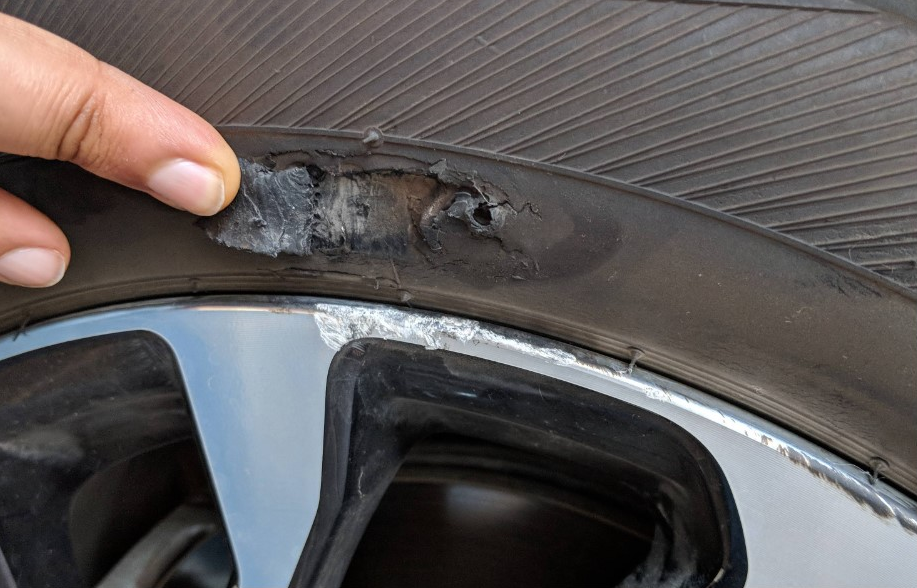Chunk missing in the tire sidewall is a common experience for off-road vehicle owners, but city drivers are still being ruled out.
When you notice the chunk missing from your tire’s sidewall, you may wonder how that happened and whether or not it should be a concern.
A chunk missing from your tire’s sidewall is commonly caused by frequent driving on unpaved roads, hitting a curb while driving, or simply driving off-road.
This tire surface condition may not be an immediate concern and can even be fixed using a Super Glue.
However, over time, the friction generated while driving will neutralize the adhesive properties, so you may need to replace the tire eventually.
This post will discuss the possibility of driving on tires with a chunk out of them and whether you should fix or replace the affected tire.
Table of Contents
Causes of Chunk of Tire Sidewall Missing
The chunk of tire sidewall can be missing when you drive over debris or on rough roads during extreme temperatures such as sun pressure or over debris.
In other words, the reason why this tire condition happens is directly associated with driving habits and environmental conditions.
Here’s how:
The sidewall of your tire can crack or tear when you hit a pothole or drive on a rough road. This possibility also does not rule out driving on unpaved roads, leading to a chunk missing.
Also, sidewall damage can occur when your tires scrape against the curb. This usually happens when you make a sharp turn that cracks or punctures the sidewall of your tires.
On the other hand, during off-road driving, the tires can roll over sharp objects that puncture the sidewall, leading to the chunk missing. Aside from these driving habits, the sidewall can become brittle due to sudden temperature changes. For example, prolonged sun exposure can dry out and crack the sidewall, leading to even a small chunk of tire sidewall missing.
When any of these happen, I recommend you check for further damage.
Can you drive on a tire with a chunk out of it?
Yes, driving on a tire with a chunk out of it is possible. However, this is only safe when you confirm that the sidewall damage hasn’t compromised the tire’s structural integrity.
Regardless, such an attempt is a risk that I won’t recommend you take. It is best to get the tire replaced. Meanwhile, some chunks’ damage is minimal, so that you can drive on the affected tire without worry. But as long as it’s sidewall damage (the tire’s most vulnerable part), you shouldn’t take any chances.
It is ideal to figure out how that missing chunk has impacted the tire’s internal structure before driving around with those tires. Neglecting a tiny chunk missing in tires can result in extensive damage and, eventually, a tire blowout.
Should I fix or replace tires with missing chunks?
Again, whether you fix or replace a tire with a missing chunk depends on the severity of sidewall damage. While some chunks may appear small on the surface, they can cause more significant damage to the tire’s internal structure.
Also, as I mentioned earlier, the tire sidewall is prone to cuts and sharp objects. Therefore, a tiny chunk in that part can develop into something more dangerous. At the initial stage, the missing chunk may not be a concern, and you can fix the affected area using super glue.
However, once the car starts generating a lot of friction while the tire rolls along the road, it can reduce the potency of the adhesive properties, thereby wearing off its strength on the sidewall.
Fixing tires with missing chunks is generally not a great idea. It would help if you replaced them instead, especially when you can see the cords inside the chunk, or it cuts deeply into the tread.
In summary
The bottom line is that a chunk missing in a tire can occur when you run over a heavy glass bottle, piece of a tailpipe, muffler, chunk of angle iron, or any obstruction that can flip the tire up against the sidewall at speed.
As you probably know, sidewalls are already quite thin and easy to puncture (even a Phillips screwdriver and minimal effort can puncture a sidewall).
The first rule of tire maintenance is that any sidewall damage necessitates an immediate replacement.
A chunk missing on a tire’s sidewall damage makes your tire more at risk for a flat. Conversely, some experts say you should fix the tire rather than replace it.
Here’s why:
Modern tires have a low profile, which means they have a thicker sidewall to support the car’s weight. For example, RunFlat tires have a reinforced sidewall that allows you to drive on them even during a puncture. So, a small gouge in a sidewall as thick as those of these modern tires wouldn’t be considered dangerous.
Still, if you can see the chords or canvas, you should replace the tire. While some who use tires with reinforced sidewalls will still choose to replace them to stop themselves from worrying, others would think it’s not worth it since these tires gulp over $300 per piece.

